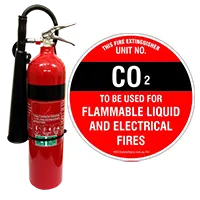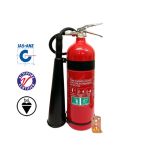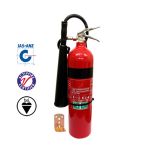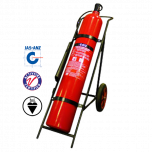 Carbon Dioxide Fire Extinguishers are most commonly used for Class E fires (Electrical) in Australia. Also known as a CO2, or Electrical fire extinguishers. Here’s a guide on how to identify them, how they work and when to use them safely:
Carbon Dioxide Fire Extinguishers are most commonly used for Class E fires (Electrical) in Australia. Also known as a CO2, or Electrical fire extinguishers. Here’s a guide on how to identify them, how they work and when to use them safely:
CO2 Carbon Dioxide fire extinguisher colour:
All new fire extinguishers in Australia are painted with a rich red colour, which is referred to as Signal Red.
A Carbon Dioxide extinguisher has a red body and will always have a BLACK colour band wrapped around the top of its cylinder.
Carbon Dioxide CO2 fire extinguisher sizes:
Available in 3 portable Sizes: 2kg, 3.5kg & 5kg.
Available in 1 mobile Size: 45kg.
How does a CO2 Carbon Dioxide extinguisher work?
Each type of extinguisher works by attempting to remove one of the elements that are needed for a fire to flourish. CO2 extinguishers are filled with carbon dioxide (a non-conductive & non-corrosive gas), an extinguishing agent that take away the oxygen element of the fire (care must be taken in confined spaces to ensure asphyxiation does not occur).
The carbon dioxide is also very cold as it comes out of the extinguisher, so it cools the fuel as well (Frost burn can occur if you do not avoid direct contact with the CO2).
When to use a CO2 Carbon Dioxide extinguisher?
CO2 extinguishers are mainly used for electrical fire risks (Class E fires). They also put out Class B fires. The extinguishing agent does not cause any damage to computer or electrical equipment, making it perfect for areas such as: Electrical Switch rooms, Server/Data rooms, Electrical machinery, Offices.
Carbon Dioxide Extinguishers:
Class B Fires - small flammable liquid fires, petrol, diesel, oil etc (limited efficiency)
Class E Fires - electrical fires, computers, photocopiers, switchboards, electrical appliances etc..

CO2 Carbon Dioxide extinguisher DO NOT USE ON:
CO2 extinguishers should not be used on fires involving flammable metals, cooking oils and also are not suitable for use on flammable gases.
Where to use a Carbon Dioxide extinguisher?
Carbon Dioxide extinguishers are recommended to be used indoors (care must be taken in confined spaces to ensure asphyxiation does not occur), from Electrical Switch rooms, Server/Data rooms, Electrical machinery, Offices and so on. In an outdoor setting, they are not very effective in windy circumstances as they have a very short discharge.
How to use a Carbon Dioxide Fire Extinguisher?
Knowing how to operate a CO2 fire extinguisher could save your life in an emergency.
The key to putting out a fire with a carbon dioxide extinguisher is to use the PASS strategy: Pull the pin, Aim the hose towards the base of the fire, Squeeze the lever, and Sweep the hose.
Remember: Fires double in size every 60 seconds so use a fire extinguisher for small, contained fires only. Leave immediately if you're unable to extinguish the fire and call 000.
CO2 Carbon Dioxide extinguisher Service & Maintenance:
In an Australian business environment, all CO2 extinguishers must undergo hydrostatic testing and recharge every five years. All CO2 fire extinguishers must carry a maintenance tag that shows their last inspection date, and must be serviced every 6 months. Once your extinguisher has been discharged, it must be pressure tested & recharged, or replaced.
They should not be installed in locations directly exposed to sunlight or radiated heat (could be discharged at temperatures exceeding 50 Degrees Celsius).
At home, CO2 extinguishers can last up to 10 years but you need to check them regularly (we recommend twice a year to check the following: pressure is at the recommended level, nozzle or hose are not obstructed, pin and tamper seal is intact, no dents, leaks, rust, chemical deposits and other signs of wear).
How to clean up after a CO2 Carbon Dioxide fire extinguisher?
Because CO2 dissipate harmlessly into the atmosphere, they leave no residue behind and require no cleanup.
CO2 fire extinguisher discharge effects to be aware of:
- Asphyxiation – CO2 remove the oxygen from the environment, care must be taken in confined spaces to ensure asphyxiation does not occur.
- Cold – CO2 is an extremely cold substance, also known as dry-ice. Frost burn can occur if you do not avoid direct contact with the CO2.
- Sound – carbon dioxide extinguishers produce a loud noise that may shock those not expecting it.
How to Refill & Recharge a CO2 Carbon Dioxide fire extinguisher:
In Australia, CO2 Fire extinguishers must be discharged and recharged every 5 Years. The refill process should be done by a trained professional (handling of pressurized chemicals). If it is not done adequately, the extinguisher could malfunction in case of an emergency.
Here are simplified steps of the CO2 refill process:
- Empty and depressurize the extinguisher (remove hose, valve assembly, clean...)
- Fill the cylinder with the amount of chemical specified on the label
- Re-Pressurize the extinguisher (check for leaks)
- Reconnect hose and ring pin
- Weigh the fully assembled fire extinguisher
CO2 Carbon Dioxide fire extinguisher Disposal & Recycling:
Carbon Dioxide CO2 Fire extinguishers are classified as a dangerous good and can not be disposed of at your household waste collection and/or curb-side collection. So how do you safely dispose of a used, expired but unused or empty carbon dioxide fire extinguisher?
Please check this article to dispose or recycle your old CO2 Fire Extinguisher: https://www.fireextinguisheronline.com.au/fire-extinguisher-recycling
You can also contact your local fire department and enquire if you can drop those off at the firehouse to dispose of them (only for expired but full or partially filled fire extinguishers). And you can contact your local council.




